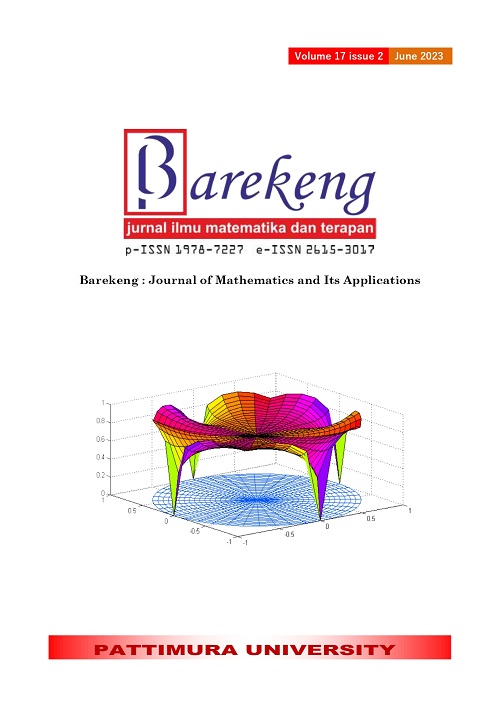NET SINGLE PREMIUM ON CRITICAL ILLNESS INSURANCE WITH MULTI-STATE MODEL
Abstract
The chances of someone getting a disease or suffering from a critical illness are very large, especially when they get older, the chances of getting a critical illness will be higher. A guarantee of the future is indispensable if a person suffers from a critical illness at any time and requires considerable costs to undergo treatment. Insurance is one of the right choices and is beneficial for people with critical illnesses. In this study, the calculation of Critical Illness insurance premiums was carried out to determine the value of premiums that must be paid by a person when suffering from a critical illness. The types of critical illnesses used include cancer, heart disease, stroke, kidney failure, diabetes mellitus, and hypertension. Health insurance that protects insureds suffering from critical illnesses is Long Term Care insurance with the Annuity as A Rider Benefit product. The multi-state model is used to determine the probability of a person suffering from a critical illness. The benefits obtained are in the form of death compensation, and treatment costs when the insured is diagnosed with a critical illness. The data used are data on the prevalence of critical illnesses and the percentage of deaths due to critical illnesses. In this study, we will compare the amount of premium that must be paid by the insured with different interest rates, gender, coverage period, and age. The higher the age at the beginning of following the insurance, the higher the premium. The higher the interest rate during the payer's period, the lower the premium.
Downloads
References
M. Agustina, "Implementasi Metode Multi Factor Evaluation Process (MFEP) dalam Membuat Keputusan untuk Memilih," Jurnal Ilmiah MATRIK, vol. 21, no. 2, pp. 108-117, 2019.
S. Maskanah, "Implementasi Produk Asuransi Jiwa Syari’ah Terhadap Kestabilan Ekonomi Keluarga," Jurnal Ekonomi dan Bisnis Islam, vol. 1, no. 2, pp. 111-128, 2016.
W. Ariani, N. Satyahadewi and H. Perdana, "Penentuan Cadangan Premi Pada Asuransi Jiwa Dwiguna Joint Life dengan Metode Premium Sufficiency," Buletin Ilmiah Matematika, Statistika dan Terapannya, vol. 9, no. 1, pp. 205-212, 2020.
R. K. Sembiring, Asuransi 1, Tanggerang Selatan: Universitas Terbuka, 2016.
F. Warni, D. Devianto and R. Husna, "Penentuang Cadangan Asuransi Jiwa Berjangka Pada Status Hidup Gabungan Menggunakan Metode Premium Sufficiency," Jurnal Matematika UNAND, vol. 6, no. 4, pp. 56-63, 2017.
S. Artika, I. G. P. Purnaba and D. C. Lesmana, "Penentuan Premi Asuransi Jiwa Berjangka Menggunakan Model Vasicek dan Model Cox-Ingersoll-Ross (CIR)," Journal of Mathematics and Its Application, vol. 17, no. 2, pp. 129-139, 2018.
C. Justiani, "Model Multi-Status Dalam Menentukan Premi Asuransi Long Term Care," Universitas Gadjah Mada, Yogyakarta, 2015.
C. P. Gumauti, Y. Wilandari and R. Rahmawati, "Penghitungan Premi Asuransi Long Term Care Untuk Model Multi Status," Jurnal Gaussian, vol. 5, no. 2, pp. 259-267, 2016.
Haryono and D. J. Ratnaningsih, Pengantar Proses Stokastik, Tanggerang Selatan: Universitas Terbuka, 2018.
W. Ekasasmita, "Multi State Model For Pricing Critical Illness," Universitas Gadjah Mada, Yogyakarta, 2015.
L. Meira-Machado, J. Uña-Álvarez, C. Cadarso-Suárez and P. K. Andersen, "Multi-state Models for the Analysis of Time-to-Event Data," Statistical Methods in Medical Research, vol. 18, no. 2, pp. 195-222, 2009.
N. Ningsih, N. Satyahadewi and H. Perdana, "Model Multi Status Dalam Penentuan Asuransi Kesehatan Penderita Penyakit Jantung," Buletin Ilmiah Matematika, Statistika dan Terapannya, vol. 8, no. 3, pp. 477-484, 2019.
S. Haberman and E. Pitacco, Actuarial Models for Disability Insurance, Florida: CRC Press Lcc, 1999.
KEMENKES, "Laporan Nasional RISKESDAS 2018," 2019. [Online]. Tersedia: http://repository.bkpk.kemkes.go.id/3514/1/Laporan%20Riskesdas%202018%20Nasional.pdf. [Diakses: 20 Agustus 2022].
WHO, "Press Release, International Agency for Research on Cancer," WHO, 2018. [Online]. Tersedia: https://www.iarc.who.int/wp-content/uploads/2018/09/pr263_E.pdf. [Diakses: 30 Maret 2022].
Copyright (c) 2023 Inggriani Millennia Taraly, Neva Satyahadewi, Hendra Perdana, Ray Tamtama, Siti Aprizkiyandari

This work is licensed under a Creative Commons Attribution-ShareAlike 4.0 International License.
Authors who publish with this Journal agree to the following terms:
- Author retain copyright and grant the journal right of first publication with the work simultaneously licensed under a creative commons attribution license that allow others to share the work within an acknowledgement of the work’s authorship and initial publication of this journal.
- Authors are able to enter into separate, additional contractual arrangement for the non-exclusive distribution of the journal’s published version of the work (e.g. acknowledgement of its initial publication in this journal).
- Authors are permitted and encouraged to post their work online (e.g. in institutional repositories or on their websites) prior to and during the submission process, as it can lead to productive exchanges, as well as earlier and greater citation of published works.






1.gif)



